Welcome to Druskininkai, Lithuania’s southernmost city and the oldest resort in the country, famous for its healing mineral water springs, impressive nature and myths and legends that arouse curiosity. Every path in the town is the subject of one legend or another. Come here if you wish to visit its natural springs, which, according to legend, bubbled up from a place where in ancient times a princess cried when she thought that the man she loved had drowned in the Nemunas, visit the famous Meilės—or Love—Island, where lovers from Druskininkai once went boating and try out the resort’s healing springs.
But don’t be fooled, however, as the resort is known not only for its spas and spectacular nature, but also for its close connection to important events in world history.
Jews began settling down in Druskininkai in the middle of the eighteenth century, and by eighteen ninety-seven they already made up about half of the city’s population. The town’s Jewish community engaged in various crafts and trades and actively contributed to the development of the resort. There were also several Jewish religious schools in Druskininkai, and the strength and pro-active nature of their community is evidenced by the charity houses and hospital for poor Jews that opened in the middle of the nineteenth century. The resort’s synagogue stood in the very heart of the city, on the right side of the current Vilniaus Alėja—or Vilnius Avenue. These Jewish places of worship were surrounded by Jewish-owned shops.
In the autumn of nineteen forty-one, a Jewish ghetto was established in the town, where around nine hundred Jews were driven into an area fenced with barbed wire. On November the second, nineteen forty-three, however, the ghetto was liquidated and the Jews were deported to the Kolbasin concentration camp near Grodno.
Today, the painful history of the Jewish people of Druskininkai is marked by a Holocaust Memorial and the Jacques Lipchitz Memorial Museum. You can visit these and other places whilst taking this tour, which will allow you to see all of the resort’s most important and interesting sights.
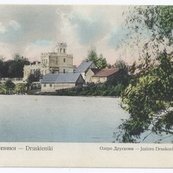 Our first stop will let you get acquainted with the history of Druskininkai. It’s best told by the Druskininkai City Museum, located in the impressive Neoclassical Linksma—or Fun—villa. Built at the beginning of the twentieth century, the villa once belonged to the aristocratic Kiersnovskis family in the Grand Duchy of Lithuania, who spent their summers here.
Our first stop will let you get acquainted with the history of Druskininkai. It’s best told by the Druskininkai City Museum, located in the impressive Neoclassical Linksma—or Fun—villa. Built at the beginning of the twentieth century, the villa once belonged to the aristocratic Kiersnovskis family in the Grand Duchy of Lithuania, who spent their summers here.
Today, the Druskininkai City Museum has only one permanent exposition about the Polish and Russian periods of the town’s history. In the museum you can look at various publications about Druskininkai during the tsarist and interwar periods, a collection of photographs by Bronisław Piłsudski, who was born in eighteen ninety-eight and who died in nineteen-o-five, and an impressive collection of art. You’ll also find a collection of antique household items marked with the specific sign of Druskininkai, photograph albums illustrating the activities of the resort’s institutions during the Soviet period and a collection of leaflets advertising mineral water spots, sanatoriums and spa centres.
For an additional fee, the Druskininkai City Museum allows you to make copies of historical documents and photocopies of its exhibits that you can take away with you after your visit. Today, the museum and its terrace host concerts, exhibitions and other cultural events, as well as the registrations of marriages.
The museum staff joke that you haven’t been to Druskininkai until you’ve visited the museum. However, if you don’t want to visit it, you can always take a walk in the adjoining park, breathe in the fresh air and enjoy the peace and quiet of the resort.
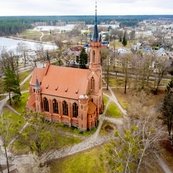 After visiting the museum, let’s travel along Druskininkai’s green paths that lead to the red brick neo-Gothic Church of Saint Mary’s Scapular, built in nineteen thirty-one. Few people know that it’s in this church that a very rare relic of Saint Valentine is preserved. Behind the Valentine’s Day celebrations held on February the fourteenth all around the world lies an interesting story about an extraordinary bishop who lived in the third century during the reign of Emperor Claudius the Second. We don’t know much about his life, and, for the most part, only legends and exciting stories survive. It’s well known that the holy bishop, who was famous for his humility and great miracles, was a famous preacher fluent in both Greek and Latin. It’s said that Claudius the Second forbade his soldiers to marry because he was convinced that a married soldier was a poor soldier because he became less cruel and less devoted to his emperor. Bishop Valentine ignored the prohibition, and conducted weddings between soldiers and their new wives in secret. The emperor, who fiercely persecuted all Christians, found such behaviour unacceptable, and ordered that Valentine be imprisoned and executed. It’s in this church in Druskininkai that a small bone from the saint’s body is preserved, respectfully kept in an ornate reliquary. Visitors to the church can visit the reliquary touch the bone inside as well as a memorial picture and a rosary, and ask for God’s intercession.
After visiting the museum, let’s travel along Druskininkai’s green paths that lead to the red brick neo-Gothic Church of Saint Mary’s Scapular, built in nineteen thirty-one. Few people know that it’s in this church that a very rare relic of Saint Valentine is preserved. Behind the Valentine’s Day celebrations held on February the fourteenth all around the world lies an interesting story about an extraordinary bishop who lived in the third century during the reign of Emperor Claudius the Second. We don’t know much about his life, and, for the most part, only legends and exciting stories survive. It’s well known that the holy bishop, who was famous for his humility and great miracles, was a famous preacher fluent in both Greek and Latin. It’s said that Claudius the Second forbade his soldiers to marry because he was convinced that a married soldier was a poor soldier because he became less cruel and less devoted to his emperor. Bishop Valentine ignored the prohibition, and conducted weddings between soldiers and their new wives in secret. The emperor, who fiercely persecuted all Christians, found such behaviour unacceptable, and ordered that Valentine be imprisoned and executed. It’s in this church in Druskininkai that a small bone from the saint’s body is preserved, respectfully kept in an ornate reliquary. Visitors to the church can visit the reliquary touch the bone inside as well as a memorial picture and a rosary, and ask for God’s intercession.
Another unique feature of the church are the four bells that hang in its tower. They fascinate people not only with their magical sound, but also with the history of their origin. The first and oldest bell features an inscription in Cyrillic that reads ‘Roku Bozhija’ and the date when it was made in seventeen fifty-four. The inscription and the Baroque decoration adorning the bell show that it’s not a Russian bell, but rather that it was made in the Polish–Lithuanian Commonwealth, somewhere in Western Ukraine or in the eastern lands of the old Lithuanian state, and belonged to the Ukrainian Greek Catholic Church. The other three bells date from much later, and were all cast in bell foundries in Poland during the interwar period.
People such as the Polish Marshal Józef Piłsudski, the linguist Juozas Balčikonis, the poet and prose writer Vincas Mykolaitis-Putinas and many other well-known figures in Lithuanian society found the church beautiful and visited it as often as they could. The Church of Saint Mary’s Scapular is an extremely valuable and impressive architectural and cultural wonder, so don’t miss the opportunity to go inside and admire the beauty that it holds.
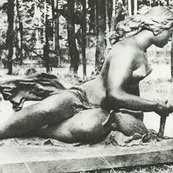 We’ll continue our journey by walking towards the bank of the Nemunas to visit one of Druskininkai’s most popular sculptures of a girl called Ratnyčėlė, sitting on high up on a pedestal. Ratnyčėlė was created in nineteen fifty-nine by the sculptor Bronius Vyšniauskas, a prize-winning laureate and professor whose monuments can be seen in Grūtas Park and other famous places in Lithuania. The sculpture depicts Druskininkai’s symbol, a woman scooping water with her hand. Although it’s adorned the resort for more than half a century, it still fascinates and exudes romance. Its high pedestal and steps reveal how high a woman’s grace can be raised, and how perfectly the dreamy rippling of the stream fits into the overall picture.
We’ll continue our journey by walking towards the bank of the Nemunas to visit one of Druskininkai’s most popular sculptures of a girl called Ratnyčėlė, sitting on high up on a pedestal. Ratnyčėlė was created in nineteen fifty-nine by the sculptor Bronius Vyšniauskas, a prize-winning laureate and professor whose monuments can be seen in Grūtas Park and other famous places in Lithuania. The sculpture depicts Druskininkai’s symbol, a woman scooping water with her hand. Although it’s adorned the resort for more than half a century, it still fascinates and exudes romance. Its high pedestal and steps reveal how high a woman’s grace can be raised, and how perfectly the dreamy rippling of the stream fits into the overall picture.
The legend of how Ratnyčia got its name is still very much alive in the minds of the resort’s older residents. According to them, a farmer once lived in the forest, whose sons didn’t want to work on their parents’ land and so had to marry and engage in various crafts. The eldest became a miller, and the youngest married a beautiful girl with no brothers or sisters and settled on her homestead on the bank of a stream near a church. He either really liked the craft of a wheelwright or was inspired by his young wife, as the family was able to make a good living and built a large house. To make it easier for people to find a talented master, a wheel with the inscription word ‘Ratnyčia’—or wheel workshop— was hung above the gate, and the house was named ‘Ratnyčėlė’. What happened next to the family remains unknown, but you can find another sculpture by Bronius Vyšniauskas Motinystė—or Motherhood— near the town’s art school.
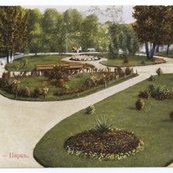 After visiting Ratnyčėlė, let’s travel along the Nemunas shore to the old city garden, but don’t forget to take your time and enjoy the fresh air. The garden, located in the heart of Druskininkai, is also known as Health Resort Park. During the nineteenth century, the lives of the people who visited the resorts revolved around this place. It’s where they went for their healing procedures, enjoyed various cultural events and spent time with their friends. Today it’s a favourite spot for locals and tourists to relax and take a quiet walk, where people can refresh themselves with some mineral water from park’s pump room. If you visit the park between ten in the morning and eleven at night, don’t miss the Musical Fountain, voted the most beautiful in Lithuania. The fountain’s beauty reveals itself at dusk, when it splashes in a variety of colours to the most popular melodies. For a small fee you can choose your own tune, watch the fountain ‘dance’ to your favourite song.
After visiting Ratnyčėlė, let’s travel along the Nemunas shore to the old city garden, but don’t forget to take your time and enjoy the fresh air. The garden, located in the heart of Druskininkai, is also known as Health Resort Park. During the nineteenth century, the lives of the people who visited the resorts revolved around this place. It’s where they went for their healing procedures, enjoyed various cultural events and spent time with their friends. Today it’s a favourite spot for locals and tourists to relax and take a quiet walk, where people can refresh themselves with some mineral water from park’s pump room. If you visit the park between ten in the morning and eleven at night, don’t miss the Musical Fountain, voted the most beautiful in Lithuania. The fountain’s beauty reveals itself at dusk, when it splashes in a variety of colours to the most popular melodies. For a small fee you can choose your own tune, watch the fountain ‘dance’ to your favourite song.
The park is laid out symmetrically in the so-called English style, and has winding paths. It also contains many spas, and a Kurhaus that once housed a bus station, a bookshop and library, a sweet shop and a theatre. In the past, visitors to the park could enjoy kefir and kumis. During the Soviet period, a mineral water pump room and other buildings for drinking mineral water were built here. In twenty eleven, the park was reconstructed and adorned with new sculptures, one of them, Karūnos—or Crowns—by the world-famous sculptor Dalia Matulaitė, created especially for the last descendant of the Jagiellon family, Sigismund Augustus and the love of this life and second wife, Barbara Radziwiłł.
The reconstructed park also has new walkways, benches, lighting and greenery, and the environment around the so-called Grožio Šaltinis—or Spring of Beauty—has been redesigned. A historical landmark that remains in the park is a river water level metre that was installed in eighteen eighty-one.
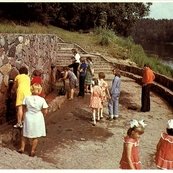 Have you ever thought how great it would be if the magical elixir of eternal youth really existed? If your answer is yes, then don’t wait any longer and go straight to the bank of the Nemunas River to another of the park’s attractions in the form or the Grožio Šaltinis—or Spring of Beauty. There’s a reason why this place has such a name. Although the spring water is too salty to drink, it’s perfect for washing your hands and face or rinsing your throat. Legend has it that the spring’s water has rejuvenating properties, and gives beauty and freshness. The spring, filled with various healing properties, flows at a depth of more than three hundred metres.
Have you ever thought how great it would be if the magical elixir of eternal youth really existed? If your answer is yes, then don’t wait any longer and go straight to the bank of the Nemunas River to another of the park’s attractions in the form or the Grožio Šaltinis—or Spring of Beauty. There’s a reason why this place has such a name. Although the spring water is too salty to drink, it’s perfect for washing your hands and face or rinsing your throat. Legend has it that the spring’s water has rejuvenating properties, and gives beauty and freshness. The spring, filled with various healing properties, flows at a depth of more than three hundred metres.
Like many other places in Druskininkai, Grožio Šaltinis has its own legend. A long time ago, a duke out hunting with some local noblemen accidentally found himself here. The hunt was successful, and the duke managed to shoot a falcon. Pierced by his arrow, the bird fell into the Nemunas, and the duke jumped into the water to grab it. The duchess stayed on the shore and ran along the banks of the river, weeping and calling out to her beloved man. After a while, the duke, alive and happy, emerged from the water with the falcon in his hands. According to the legend, salty springs, the ones you’re currently standing by, then erupted from the ground in the places where the duchess’ tears had fallen. After testing the spring’s healing properties, let’s travel to the next sight, a monument dedicated to the prominent Lithuanian artist Mikalojus Konstantinas Čiurlionis.
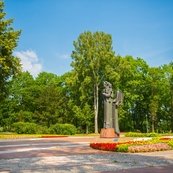 The work of Vladas Vildžiūnas, Druskininkai’s monument to the famous Lithuanian painter and composer Mikalojus Konstantinas Čiurlionis was unveiled in nineteen seventy-five to commemorate the hundredth anniversary of the artist’s birth.
The work of Vladas Vildžiūnas, Druskininkai’s monument to the famous Lithuanian painter and composer Mikalojus Konstantinas Čiurlionis was unveiled in nineteen seventy-five to commemorate the hundredth anniversary of the artist’s birth.
Čiurlionis’ personality is a symbol of Lithuanian identity, and his work is a testimony to the modernity of Lithuanian and European art at the beginning of the twentieth century. The versatility of Mikalojus Konstantinas Čiurlionis’ talent revealed itself not only through painting and music, but also by the spoken word and photography.
You’ll learn more about the life of the artist when you visit the Mikalojus Konstantinas Čiurlionis Memorial Museum. In the meantime, let’s learn about the history of the sculpture.
In nineteen seventy-five, it was planned to transport the bronze sculpture to Druskininkai, which at the time was located in Vilnius, in a special way. After stopping at the Varėna intersection, the monument was supposed to be attached to a helicopter and flown to where it stands today. The idea was abandoned due of the excessive risk involved. If the cable attached to the helicopter broke, the monument would no longer exist. Perhaps it was the decision not to transport the sculpture by air that influenced the fact that today, thanks to many masters of folk art, we have the so-called Mikalojus Konstantinas’ trial leading from his native Varėna to Druskininkai, which is known for its amazing carvings.
To immortalise Čiurlionis’ genius, it was decided to create the sculpture in such a way that it appeared to have wings, symbolising the things beyond the capabilities of an ordinary person.
Along with the architect Rimantas Dičius, Vladas Vildžiūnas was awarded the Republican Prize for the monument.
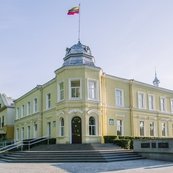 After visiting the sculpture, return to the Druskininkai Municipality building by the park’s main road.
After visiting the sculpture, return to the Druskininkai Municipality building by the park’s main road.
The building was previously inhabited by one of the richest inhabitants of the resort, the Lithuanian-Polish Walery Bujakowski, who was born in eighteen sixty and who died in the United States in nineteen nineteen. It’s believed that Bujakowski’s brick villa was built in the late nineteenth or early twentieth century. Initially it was a one-storey building, with the upper floor added later whilst preserving all of the original roof-dome shapes.
After learning what the house of the richest resident of the resort once looked like, let’s continue the journey and travel on to our next stop, the Church of the Icon Mother of God Joy of All Who Sorrow.
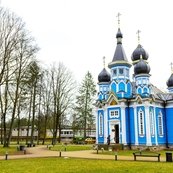 Built in eighteen sixty-five and one of the oldest surviving wooden buildings in the resort, the Church of the Icon Mother of God Joy of All Who Sorrow is Druskininkai’s only Russian Orthodox church. Along with its other exceptional and unique architectural forms, the building’s exterior shows the clear features of a typical Russian house of worship and details typical of the periods of Romanticism and Historicism. Let’s go inside and admire its architecture.
Built in eighteen sixty-five and one of the oldest surviving wooden buildings in the resort, the Church of the Icon Mother of God Joy of All Who Sorrow is Druskininkai’s only Russian Orthodox church. Along with its other exceptional and unique architectural forms, the building’s exterior shows the clear features of a typical Russian house of worship and details typical of the periods of Romanticism and Historicism. Let’s go inside and admire its architecture.
Upon leaving, you should be able to notice that the church is built in the centre of a diamond-shaped square in the way that most Russian Orthodox churches are built. Why, you might ask? In this way, the building’s designers ensured that people could admire it from all sides. Don’t miss the opportunity to get a selfie outside the extremely photogenic church—its exceptional bright blue colour and interesting architectural details make the building look truly impressive in photographs.
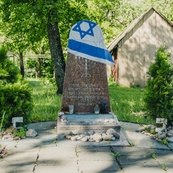 Close to the church is Druskininkai’s Holocaust Memorial, created in nineteen ninety-two by an unknown author to commemorate the town’s Jewish victims during the Second World War. There used to be a Jewish ghetto in this place, and today visitors know it as the location of the Vilna Gaon Museum of Jewish History.
Close to the church is Druskininkai’s Holocaust Memorial, created in nineteen ninety-two by an unknown author to commemorate the town’s Jewish victims during the Second World War. There used to be a Jewish ghetto in this place, and today visitors know it as the location of the Vilna Gaon Museum of Jewish History.
A Star of David, a menorah and the words ‘Prisoners of the Jewish Ghetto’ are all engraved on the monument’s polished stone surface.
We’ll now visit the Jacques Lipchitz Memorial Museum, where you’ll learn about a world-famous Jewish artist who was born in Druskininkai.
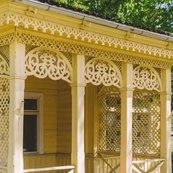 Jacques Lipchitz was a world-famous Cubist sculptor of Lithuanian Jewish origin who was born in Druskininkai but who spent most of his life working in France, the USA, Israel and Italy. Born on August twenty-second, eighteen ninety-one into the family of the businessman Abraham Lipchitz, who came to Druskininkai from Grodno, and Rachel Leah Krinsky, the sculptor was born Chaim Jacob, but later changed his name.
Jacques Lipchitz was a world-famous Cubist sculptor of Lithuanian Jewish origin who was born in Druskininkai but who spent most of his life working in France, the USA, Israel and Italy. Born on August twenty-second, eighteen ninety-one into the family of the businessman Abraham Lipchitz, who came to Druskininkai from Grodno, and Rachel Leah Krinsky, the sculptor was born Chaim Jacob, but later changed his name.
Various sources reveal that unbeknownst to his father the young Chaim secretly received his mother's modest support in the form of earrings with precious stones. After that, he left his native Druskininkai for Paris and renamed himself Jacques. It was extremely difficult for his father to come to terms with his son’s departure and the profession that he’d chose, as he hoped that his gifted eldest son would acquire a practical profession and help him develop his own construction business.
Despite some initial concerns, Paris welcomed Jacques with open arms, where he met and befriended many of the greatest artists of the time, among them the Cubist pioneers Pablo Picasso and Juan Gris as well as Amedeo Modigliani, Diego Rivera, Chaim Soutine and Moïse Kisling. After renting a studio in Montparnasse next to the Romanian artist Constantin Brâncuși, Lipchitz received his first recognition and commission in nineteen twenty when his first solo exhibition was held at the Paris’ Rosenberg Gallery. Among the artist’s most famous works are Vyras su Gitara—or Man with a Guitar—Besimaudančioji—or The Bather—and Gyvenimo Džiaugsmas—or Joy of Life.
Until he was seventeen, the young artist lived with his parents and brothers and sisters in a brick house on the other side of Šventojo Jokūbo—or Saint Jacob’s—Street, in front of the present-day museum. Having worked and gained world fame, the artist never forgot his native Druskininkai and his roots of origin. In a letter to the well-known painter Aleksis Rannit, Lipchitz wrote the following: ‘It’s true that Čiurlionis was a real genius. And I’m proud to have been born in a village whose ground was touched by his feet. Our lovely, unforgettable Druskininkai!’.
In nineteen ninety-six, a memorial museum was established in the artist’s memory inside a small wooden building that was originally constructed as a residential house during the first half of the twentieth century. The new exposition in the museum will reveal the history of the artist’s life and work with particular attention to the Lipchitz’s ties with Lithuania, which remained strong despite the Soviet occupation that separated the artist from his homeland.
Jacques Lipschitz died in Italy on May the sixteenth, nineteen seventy-three and was buried in Jerusalem.
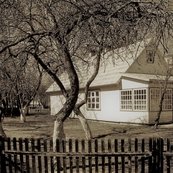 After getting acquainted with the famous Lithuanian Jewish sculptor, it’s time to learn more about one of the most outstanding Lithuanian artists of all time—Mikalojus Konstantinas Čiurlionis, which is why we’re currently on our way to his museum. On the main street in Druskininkai named after the artist and established in nineteen sixty-three, the museum is located inside two houses in which he lived and worked. Čiurlionis was born in Varėna to the organist Konstantinas Čiurlionis and Adele Marija Magdalena Radmanaitė-Čiurlionienė. The entire family moved to Druskininkai in eighteen seventy-eight.
After getting acquainted with the famous Lithuanian Jewish sculptor, it’s time to learn more about one of the most outstanding Lithuanian artists of all time—Mikalojus Konstantinas Čiurlionis, which is why we’re currently on our way to his museum. On the main street in Druskininkai named after the artist and established in nineteen sixty-three, the museum is located inside two houses in which he lived and worked. Čiurlionis was born in Varėna to the organist Konstantinas Čiurlionis and Adele Marija Magdalena Radmanaitė-Čiurlionienė. The entire family moved to Druskininkai in eighteen seventy-eight.
Located inside the former Čiurlionis family home, the museum shows how the famous artist lived. According to the artist’s sisters Valerija and Jadvyga, the museum did a great job at recreating the authentic interior of the cottages and the homestead in which the family all lived together. The museum features a permanent exposition housed in four separate houses. In the first house, you’ll find a biographical exposition dedicated to the artist. In the second, a collection of authentic historical family artefacts, and in the third house, you’ll get acquainted with the artist’s most famous works. Visitors to the museum can book a tour in Russian and find out some more interesting facts about one of the most outstanding Lithuanian artists that they never knew before.
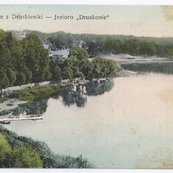 After visiting the museum, let's travel to Druskonis Lake where you’ll be able to relax and enjoy the area’s beautiful nature. You must have already seen some images of the lake when you visited the Druskininkai City Museum.
After visiting the museum, let's travel to Druskonis Lake where you’ll be able to relax and enjoy the area’s beautiful nature. You must have already seen some images of the lake when you visited the Druskininkai City Museum.
It’s said by some that during ancient times the family of Druskiai Jonas lived near Druskonis Lake, and this is where the name of the lake came from. A few centuries ago, the lake signified that visitors to the town who were exhausted from their trip finally found the oasis of peace that they needed in Druskininkai. The street that runs above the southern shore of the lake is the main historical road from Grodno. Along its shore are centuries-old pines, depicted in postcards dating back to the nineteenth century. On the lake’s northern bank, the Druskininkai City Museum with its impressive terrace catches the visitor’s eye, and on the other the Old Town and the Soviet cemetery. During the summer, visitors to the resort are fascinated by its flower gardens and enjoy the pleasant and refreshing coolness that comes from the fountain. In the warmer months, you can go boating on the lake. Its shoreline is also suitable for cyclists and joggers.
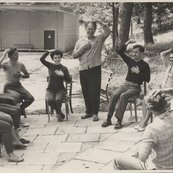 Located in a pine forest on the bank of the Ratnyčia River just a ten-minute walk from the Mikalojus Konstantinas Čiurlionis Museum is the Karolis Dineika Wellness Park, an oasis of refreshment and a really relaxing place.
Located in a pine forest on the bank of the Ratnyčia River just a ten-minute walk from the Mikalojus Konstantinas Čiurlionis Museum is the Karolis Dineika Wellness Park, an oasis of refreshment and a really relaxing place.
The park was founded in nineteen twenty-four by the famous Polish doctor Eugenia Levicka, whose believed in sport, fitness and sunbathing as effective alternatives to traditional medicine. In nineteen fifty-two, the Lithuanian pedagogue and specialist in therapeutic physical culture Karolis Dineika became the head of the park, which is where it gets its name from today.
The Karolis Dineika Wellness Park still fully respects the traditions of air, water and Sun procedures. Visitors can try unique treatments, enjoy the benefits of dosed walking, cleanse their bodies with ion therapy, enjoy the Sun and tranquillity on the terraces or try out a foot massage in the acupressure pool. Your entire body will benefit from the procedures that the resort is known for. After a rest in the park, you’ll have the strength to visit the next stop on the tour, – the Girios Aidas—or Echo of the Woods—forest museum, which can be reached on foot in twenty-five minutes.
 Nature lovers, listen up. We’re now heading towards the Girios Aidas forest museum, located in a truly unique cottage in the forest on the edge of town. Here you’ll see an exposition about the forest, the rare species of plants and animals that live in it and learn about the traditional crafts of the region.
Nature lovers, listen up. We’re now heading towards the Girios Aidas forest museum, located in a truly unique cottage in the forest on the edge of town. Here you’ll see an exposition about the forest, the rare species of plants and animals that live in it and learn about the traditional crafts of the region.
The museum houses a collection of hunting trophies, and on the second floor there’s an impressive collection of forest birds, beasts, insects and other animals.
Next to the museum is a forest trail, complete with wooden sculptures, roof pillars, benches and wood carvings made by some of the most famous folk artists in the country.
This can be either the beginning of the tour (boat trip from the bank of the Nemunas) or its end to return to the bank of the Nemunas after visiting the Girios aidas forest museum. Other objects can be reached by car or public transport.
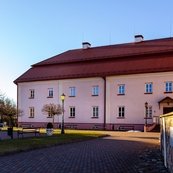 Liškiava is a tiny old village in the Dzūkija Region, famous for its church and monastery. Some twelve kilometres north of Druskininkai, as little as twenty-five people live in the village today, but tourists flock here every year. Not only do they want to visit the special ensemble of the Liškiava Dominican Monastery, they are also come to see the surrounding nature in which the monastery is located in a picturesque bend of the Nemunas River.
Liškiava is a tiny old village in the Dzūkija Region, famous for its church and monastery. Some twelve kilometres north of Druskininkai, as little as twenty-five people live in the village today, but tourists flock here every year. Not only do they want to visit the special ensemble of the Liškiava Dominican Monastery, they are also come to see the surrounding nature in which the monastery is located in a picturesque bend of the Nemunas River.
It’s said that the eighteenth century was a period of prosperity for the Dominicans of Liškiava, as it was then that the brick monastery and church were finally built. On April the twenty-second, sixteen ninety-seven, along with his wife Kristina, the governor of Liškiava Vladislovas Jurgis Kosyla bequeathed all their wealth to the monastery so that the monks would pray for them and their deceased son, their only child, Florian. After consulting with a Dominican order in Sejny, Kosyla decided to establish a new monastery and build a church in honour of the Holy Trinity in the village.
This is how the valuable late Baroque architectural ensemble of the seventeenth century emerged. Special boat tours leave Druskininkai for Liškiava during the summer holiday season.
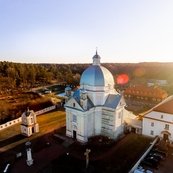 The undisputed star of the monastery ensemble, Liškiava’s Church of the Holy Trinity is an impressive building built in the late Baroque style. The monumental organ made in eighteen ninety-nine in Warsaw by the Polish master Shimanski has survived, as have the carved wooden benches that have been standing here for more than two hundred and fifty years, several Baroque and Rococo style altars and many other religious monuments dating from the seventeenth to the twentieth century.
The undisputed star of the monastery ensemble, Liškiava’s Church of the Holy Trinity is an impressive building built in the late Baroque style. The monumental organ made in eighteen ninety-nine in Warsaw by the Polish master Shimanski has survived, as have the carved wooden benches that have been standing here for more than two hundred and fifty years, several Baroque and Rococo style altars and many other religious monuments dating from the seventeenth to the twentieth century.
The church, adorned with historically valuable paintings and murals, has preserved the original burial cellar of the Dominican monks, who lay here in eternal rest.
If you want to visit it and see it with your own eyes, you can book a sightseeing tour of the church, during which you will be introduced to its architecture and art treasures. You’ll also be able to visit the church cellars with the surviving remains of the eighteenth-century Dominican monks and an exposition of liturgical heritage from the seventeenth to the twentieth century.
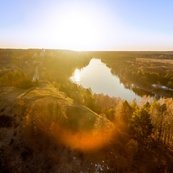 Walk from the monastery for about ten minutes and you’ll find yourself at the Liškiava Hill Fort, also known as the Witch’s Masonry and Perkūnas’ Sanctuary. The fort is located on the slope of the Nemunas, in the old settlement of Liškiava. The prevailing theory that seems to be generally accepted says that a stone castle was built at the beginning of the fifteenth century in Liškiava, even before the Battle of Grunwald, but was never finished. Although there are no reliable historical sources today about the castle that once stood here, you can feel the great spirit of the past by climbing the hill fort, which offers an impressive panorama of the surrounding nature and the remains of the castle tower. You can also see the nearby ensemble of the Church of the Holy Trinity and the Dominican Monastery, which attracts visitors from all over Lithuania and abroad.
Walk from the monastery for about ten minutes and you’ll find yourself at the Liškiava Hill Fort, also known as the Witch’s Masonry and Perkūnas’ Sanctuary. The fort is located on the slope of the Nemunas, in the old settlement of Liškiava. The prevailing theory that seems to be generally accepted says that a stone castle was built at the beginning of the fifteenth century in Liškiava, even before the Battle of Grunwald, but was never finished. Although there are no reliable historical sources today about the castle that once stood here, you can feel the great spirit of the past by climbing the hill fort, which offers an impressive panorama of the surrounding nature and the remains of the castle tower. You can also see the nearby ensemble of the Church of the Holy Trinity and the Dominican Monastery, which attracts visitors from all over Lithuania and abroad.
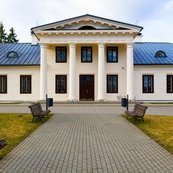 When you return from a boat trip, don’t miss the opportunity to visit the beautiful Leipalingis Manor, a residence once owned by the famous Sapieha family of noble Lithuanians in the place of Leipalingis, some sixteen kilometres north of Druskininkai. Get there from Druskininkai on bus number thirty-three in about thirty minutes.
When you return from a boat trip, don’t miss the opportunity to visit the beautiful Leipalingis Manor, a residence once owned by the famous Sapieha family of noble Lithuanians in the place of Leipalingis, some sixteen kilometres north of Druskininkai. Get there from Druskininkai on bus number thirty-three in about thirty minutes.
The manor was first mentioned in historical sources on April the seventh, fifteen-o-three, when Alexander donated it to Jan Teodor Plushkov, who’d fled the land of Smolensk that had been occupied by Prince Ivan the Third of Moscow. Later, on June the twenty-eight, fifteen-o-eight, when the manor was left without an owner, Sigismund the Old gifted it to Jan Sapieha. In fifteen twenty, the Sapieha family built a church here. During the reign of Jan’s son Paweł Sapieha, a large fire broke out at Leipalingis Manor, during which the church and many buildings burned down. Later, after the family became Catholics, Mikołaj Sapieha sponsored the construction of a new church and rebuilt the manor.
The Sapieha family ruled the manor until seventeen forty-two. Later, it belonged to Masalskis and Plater families. At the beginning of the nineteenth century, Leipalingis belonged to the Kruševskis family, and at the beginning of the twentieth century, the manor was bought by a merchant and engineer from Saint Petersburg by the name of Piotr Baliński. Baliński took care of the manor, dug canals, maintained the park, dug a lake and built luxurious bridges.
The last owner of the manor, Košica, lost the manor at a casino in Monte Carlo casino, where he ended his life with a gun.
Leipalingis Manor is one of the most important historical buildings that make up the architectural heritage of the Dzūkija region. The Classicist-style manor now houses a school, an eldership, a library and a unique museum of local lore with more than twelve thousand exhibits. In the museum, which is open all year round, you can find out who ruled the manor after the Sapieha family and what life was like there when the new owners finally arrived. You’ll also get acquainted with the various types of entertainment that were once popular at the manor, and find out what exactly makes the museum located in the manor so fascinating. During a visit to the museum, you’ll be able to follow in the footsteps of the manor’s former landlords, take part in the lessons of the lady of the manor and learn the dances that were once so popular here.
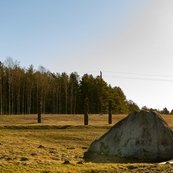 When you return from Leipalingis, you should visit another legendary sight in the region—the legendary Devil’s Stone in the village Švendubrė, some seven kilometres or so south of Druskininkai. Legend has it that this, the tenth largest boulder in Lithuania, was brought by the Devil himself. It’s said that he carried the stone with him because he wanted to dam up the Nemunas, but suddenly the Sun came out and a rooster began to crow. Frightened, the Devil lost the stone and disappeared into thin air, and the stone rolled down to Švendubrė where it stands to this day.
When you return from Leipalingis, you should visit another legendary sight in the region—the legendary Devil’s Stone in the village Švendubrė, some seven kilometres or so south of Druskininkai. Legend has it that this, the tenth largest boulder in Lithuania, was brought by the Devil himself. It’s said that he carried the stone with him because he wanted to dam up the Nemunas, but suddenly the Sun came out and a rooster began to crow. Frightened, the Devil lost the stone and disappeared into thin air, and the stone rolled down to Švendubrė where it stands to this day.
Another legend says that the Devil carried the stone to destroy the village of Raigardas, because people were having too much fun there. Even the horrible Lucifer envied its inhabitants for their ingenuity and happy nature. Every day, wicked evil spirits that the Lithuanians used to call kipšiukai would mumble to themselves that they, too, want to have as much fun as the people in the village. As time went by, Lucifer had enough of the kipšiukai’s complaints and got hold of the biggest stone that he could find. In the morning, when the people from Raigardas stopped their celebrations and fell asleep, he wanted to destroy them because he hated any kind of competition.
But as soon as Lucifer, carrying the huge stone on his shoulders, approached the village, a rooster crowed. The devil lost all of his power, and so he threw the stone away and disappeared back into his kingdom.
Three metres high and seven metres long, the stone was intended to be broken up and used for the construction of a new church in Druskininkai in eighteen forty-one, and again for the construction of the a new church in Ratnyčia in around nineteen-o-five. The locals however, who considered the stone to be sacred, didn’t allow it, and it survives to this day. Eventually, farmers in the area broke the stone apart and used the pieces for their own needs. During Mass in May nineteen thirty-six, some Catholic priests from Grodno visited the stone and consecrated the metal cross that they’d brought with them, which was placed on top of the stone. During the Soviet period, the cross was broken, and there was a mark left in the stone where the cross used to be.
Today, next to the stone are several wooden sculptures called Varpininkas—or The Bell Ringer—Raigardo legenda—or The Legend of Raigardas—and Piemenaitė—or The Shepherdess—all of them adorned with the motifs of legends.
Raigardas can be reached from Druskininkai in about twenty minutes by taking buses number one, five A or six.
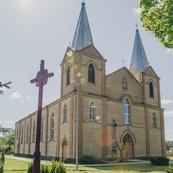 After returning to Druskininkai, travel to the Laisvės Aikštė bus stop near the Musical Fountain and take a twenty-minute ride on bus number three to the beautiful Church of the Apostle Saint Bartholomew in Ratnyčia.
After returning to Druskininkai, travel to the Laisvės Aikštė bus stop near the Musical Fountain and take a twenty-minute ride on bus number three to the beautiful Church of the Apostle Saint Bartholomew in Ratnyčia.
The church stands on or near the site of several former houses of worship, among them the so-called filial church of Merkinė—or the church without a parish—that was built in sixteen fifty by the nobleman Kazimierz Leon Sapieha, and another church constructed in sixteen seventy-six by Michał Pac. Unfortunately, neither building survives to this day. In seventeen sixty-two, a wooden church was built at the site that survived longer that its predecessors, although this one also didn’t survive.
With the help of a priest called Pranciškus Bernotas and donations from the parishioners and other benefactors, the church was rebuilt in nineteen ten. So come inside the spacious masonry church built in the Lithuanian Gothic-style and named after Apostle Bartholomew, one of the twelve Apostles mentioned in the New Testament, where you’ll be able to admire its beauty and find your inner peace.
Druskininkai Town Museum is located in the impressive Neo- Classical villa of Linksma that was built in the beginning of the 20th century. This villa was once a summer residence of the Kiersnovski family, aristocrats of the Grand Duchy of Lithuania. It is now a symbol of the Druskininkai Resort, and concerts, exhibitions, other cultural events and marriages take place both in the museum and on its terrace.
Read moreThe Neo-Gothic Holy Virgin Mary Church, built in 1931, was liked by the Polish Marshal Jozef Pilsudski, and it was often visited by the linguist Juozas Balčikonis, the poet and prose writer Vincas Mykolaitis-Putinas, and many other famous Lithuanian public figures. The Holy Virgin Mary Church is an extremely valuable and impressive place in terms of both architecture and culture.
Read moreThe Ratnyčėlė sculpture, created by the famous Lithuanian sculptor Bronius Vyšniauskas, was built on the coast of the Ratnyčia River in 1959. This work depicts the symbol of Druskininkai – a woman who is scooping up water. Every year, during a Thanksgiving event, the distinguished citizens of Druskininkai are awarded with replicas of the Ratnyčėlė sculpture.
Read moreThe Health Resort Park is the town’s oldest garden, situated in the historic area of Druskininkai. In the 19th century, it was the centre of the visitors’ daily activities including treatments, entertainment and interactions. The garden’s layout is symmetrical, and its individual parts are based on an English-style garden with winding paths. It has health facilities and a Kurhauz. In the past, the Kurhauz had a station, bookstore-library, confectionary and a theatre hall, and people could have a drink of kefir or kumis there. During Soviet times, a Buvette over a mineral spring was built, along with other buildings for drinking the mineral water. In 2011, the park was reconstructed and new sculptures, paths, benches and lighting were added, new greenery was planted, and the Beauty Spring surroundings were changed. Another historical landmark in the park is a river water level gauge that was built in 1881.
Read moreBeauty Spring is the most salty and the deepest spring in Druskininkai, which has skin cleansing and rejuvenating properties. The spring flowing from the stone bas-relief near the Nemunas River is more than 300 metres deep. The spring water is especially salty, so drinking it is not recommended. However, the water can be used to wash your face and hands, or to rinse your throat. It is believed that the water rejuvenates the skin, providing it with beauty and invigoration. According to legend, in ancient times a duke accidentally found himself in this place while hunting. The hunt was successful, so the duke had to shoot down a falcon. Pierced by a well-aimed arrow, the falcon fell into the Nemunas and the duke jumped into the water to grab it. On the shore, his duchess began to cry and run along the banks of the river, pouring out salty tears and shouting for her husband. After a while, the duke emerged from the water alive and unhurt, with the falcon in his hands. According to the legend, the salty springs broke through from the places on the ground where the duchess’ tears had fallen.
Read moreMikalojus Konstantinas Čiurlionis was the most famous Lithuanian artist. He grew up and worked in Druskininkai, and he often mentioned his love of the resort in his letters. The monument to Čiurlionis was built by Vladas Vildžiūnas in 1975, in order to commemorate the 100th Anniversary of Čiurlionis’ birth. V. Vildžiūnas and the architect R. Dičius received a national award for this monument.
Read moreToday, Druskininkai Municipality is located inside a building that once belonged to a famous doctor of Lithuanian-Polish origin, Walery Bujakowski. It’s known that he was one of the richest residents of the resort, and actively supported the activities of its many spas.
Doctor Bujakowski died in 1919 in the United States, and it’s believed that his brick villa was built in the late 19th or early 20th century. Originally a one-storey building, a second floor was later added without destroying the building’s original roof-dome shapes.
Read moreThe Church of the Mother of God’s icon named ‘The Joy of All Mourners’ was built in 1865, and it is one of the oldest wooden architecture objects in Druskininkai to have been preserved to this day. The shape of the church clearly resembles some of the features of a Russian Orthodox church. There also are details which are typical of the Romantic and Historical periods, as well as unique and exceptional architectural forms.
Read moreRight next to the Church of the Icon of the Mother of God ‘Joy of All Who Sorrow’ is a Holocaust Memorial. In the autumn of 1941, a Jewish ghetto surrounded with a barbed wire fence was established in Druskininkai into which approximately 1,000 Jews were driven. In November in the following year however, the ghetto was liquidated and the Jews were deported to the Kolbasin concentration camp near Grodno. During this period, over 30 percent of the population of Druskininkai were murdered.
In memory of this tragedy, in 1992 an unknown artist created a memorial to commemorate the Jewish victims on the site of the former ghetto. Today, the Vilna Gaon Museum of Jewish History is located next to the memorial.
A Star of David, a menorah and an inscription in Yiddish, Lithuanian and Russian saying ‘Prisoners of the Jewish Ghetto’ are all engraved into the monument’s brown polished stone.
Read moreBorn in Druskininkai in 1891, Jacques Lipchitz is a world-famous Cubist sculptor of Lithuanian Jewish origin who lived and worked in France, the USA, Israel and Italy.
He received his first recognition and commission in 1920, when his first solo exhibition was held at the Rosenberg Gallery in Paris. His most famous works are Vyras su Gitara—or Man with a Guitar—Besimaudančioji—or The Bather—and Gyvenimo Džiaugsmas—The Joy of Life.
In 1996, a memorial museum dedicated in his honour was established in Druskininkai. Employing an anthropological perspective and the regional socio-cultural context of the 20th century, the new exposition of the museum presents both the artist’s creative and personal life. Particular attention is paid to the sculptor’s ties with Lithuania, which have remained strong despite the Iron Curtain that separated the artist from his homeland.
Read moreMikalojus Konstantinas Čiurlionis, the most outstanding Lithuanian artist of all time, was born in Varėna, into the family of the organist Konstantinas Čiurlionis and Adelė Marija Magdalena Radmanaitė-Čiurlionienė. In 1878, the Čiurlionis family settled in Druskininkai. In memory of the Čiurlionis, the homestead belonging to his parents was preserved, and in 1963 the Mikalojus Konstantinas Čiurlionis Memorial Museum was established there. Based on the memoirs of Čiurlionis’ sisters, Valerija and Jadvyga, the authentic interior of the houses and the environment of the homestead were restored. This professional painter and musician has become a symbol of the Lithuanian identity, and his creative works are a testament to the modernity of 20th century Lithuanian and European art. The versatility of Čiurlionis’ talent is expressed through his music, art, literature and photography.
Read moreThe coast of Druskonis Lake is one of the most beautiful areas for relaxation in Druskininkai. The area of Druskonis Lake is 7.5 ha. According to legend, the family of Druskis Jonas lived here a long time ago, and the lake was named after them. In former times, this small lake would greet the first guests of the resort after their tiring journey. For them, it meant they had finally reached their destination. The road that goes along the southern coast of the lake is the main historic road from Gardinas. Centennial pines grow there, which were already pictured in 19th century postcards, and are now illuminated at night. On the northern shore of the lake, the Druskininkai Town Museum building features an impressive terrace, while on the opposite shore you can visit the town’s Old Cemetery. In the summer, visitors can enjoy the lovely flower gardens and a refreshingly cool fountain. During the warm months, you can also rent a boat or a water bike to row or paddle around the lake. The coast is a great destination for cyclers, runners and hikers.
Read moreKarolis Dineika Wellness Park is a relaxing oasis, located in a beautiful pine forest on the coast of the Ratnyčia River. The park continues the old traditions of treatment focused on the air, water and sun, and offers visitors unique procedures to try: walking on special treatment pathways, ionotherapy, sun and tranquillity on the terraces, or a foot massage in an acupressure pool.
Read moreGirios Aidas Forest Museum is located in a house with the original architecture, surrounded by the woods. In the museum, you can see stuffed Lithuanian animals and birds, as well as art works created by folk artists. Wooden sculptures, roof poles, benches and other ornamental wood carvings are exhibited around the museum, created by A. Česnulis, S. Vaida, A. Lastauskas, A. Raugala, J. Videika and other folk artists known throughout Lithuania.
Read moreLiškiava is an old village in the Dzūkija Region, which is known for its Blessed Trinity Church and former Dominican monastery. The 18th century was a period of prosperity for the Liškiava Dominicans, and they built a stone monastery and a church during this time. In 1999, the monastery ensemble was reconstructed and a part of it was transferred to a public organisation. Nowadays, it is a place where conferences and meetings are held. Accommodation can also be provided in the old monastery rooms.
Read moreLiškiava is an old village in the Dzūkija Region that is known for its outstanding late-Baroque Blessed Trinity Church and former Dominican monastery. Today, the church is included in the cultural heritage register. Visitors can go on a guided tour of the 17th century church and its crypts where the remains of the Dominican monks rest, as well as seeing a liturgical heritage exhibition.
Read moreLiškiava Mound, also called Raganos mūras and Perkūno šventinyčia, is located in the settlement of Liškiava, on the shores of the Nemunas. Based on the historiographic evidence, the construction of the brick-walled castle of Liškiava began at the beginning of the 15th century before the Battle of Žalgiris, and it remained unfinished. However, there are no direct historical sources that can tell us about it. Looking from the top of the mound, you can see an impressive natural landscape and the remains of a castle tower, as well as the Blessed Trinity Church and Dominican monastery which attract visitors from all over Lithuania and from abroad.
Read moreLeipalingis Manor was built in 1830 and is one of the most important objects to represent the historical architectural heritage of Dzūkija. The Classical-style manor is now the site of a school, a regional administration office, a library and a unique ethnography museum with over 12,000 exhibits.
Read moreAccording to legend, the devil was carrying a large stone in order to block the flow of the Nemunas River, but the dawn started to break and a rooster sang unexpectedly early. The devil took fright, lost the stone and disappeared, while the stone rolled toward Švendubrė and continues to lie there to this day. Nowadays, there are wooden sculptures of the Bell Ringer, the Legend of Raigardas and the Shepherd Girl based on various legends that have been erected near the stone.
Read moreThe Lithuanian Gothic-style church of the Apostle St. Bartholomew dates back to 1650, and was established by the nobleman Kazimierz Leon Sapieha. At that time, the house of worship, which was named after one of the 12 apostles mentioned in the New Testament, was the filial church of Merkinė—the so-called church without a parish.
In 1676, Michał Pac built another church here, and in 1762 a wooden church was built on the site. Unfortunately, neither of these buildings survived. In 1910 however, on the initiative of the priest Pranciškus Bernotas and with the help of donations from local parishioners and benefactors, the Church of the Apostle St. Bartholomew was rebuilt, brought back to life and opened once again for the local Catholic community.
Read more
Reviews